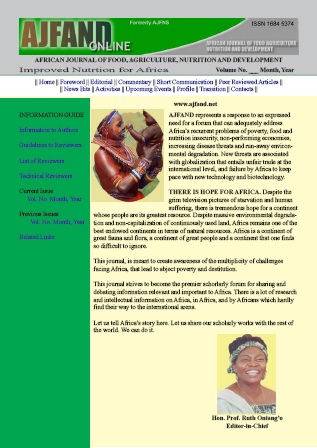
|
African Journal of Food, Agriculture, Nutrition and Development
Rural Outreach Program
ISSN: 1684-5358
EISSN: 1684-5358
Vol. 10, No. 10, 2010, pp. 4254-4267
|
 Bioline Code: nd10110
Bioline Code: nd10110
Full paper language: English
Document type: Research Article
Document available free of charge
|
|
|
African Journal of Food, Agriculture, Nutrition and Development, Vol. 10, No. 10, 2010, pp. 4254-4267
| en |
Effects Of Seeding Rates On Forage Yield And Quality Of Oat (Avena Sativa L.) Vetch (Vicia Sativa L.) Mixtures Under Irrigated Conditions Of Madagascar
Rahetlah, V.B.; Randrianaivoarivony, J.M.; Razafimpamoa, L.H. & Ramalanjaona, V.L.
Abstract
Forage availability and quality during the dry and cool season is a major constraint to dairy development in the Highlands of Madagascar. The objective of the present study was to determine optimal seeding of oat and common vetch mixtures for increased production and quality of forage. The study was conducted under irrigated conditions in two agro-ecological zones of the Vakinankaratra region in the Highlands of Madagascar. Seed proportions studied were oat-vetch 100:0; 0:100; 50:50 and 50:75. Pure stands of oat and vetch were seeded at the rate of 100 and 60kg ha-1, respectively. Standard fertilization for forage oat production was uniformly applied on each plot. Pure stands and mixtures were given two successive cuts at flag leaf stage of oat. For both sites and their average, dry matter (DM), feed unit for lactation (UFL), crude protein (CP), and protein digested in the small intestine (PDI) yields were not significantly (p>0.05) different among mixtures and pure stands. The highest yields were obtained from the 50:50 mixture at the first site and from the 50:75 mixture at the second site. According to the two sites' results' average, the highest DM (7.71 t ha-1), UFL (6.08x103 units ha-1), CP (1.64 t ha-1) and PDI (597.1kg ha-1) yields were obtained from 50:50 mixture. There were no significant differences (p>0.05) in forage quality characteristics except for CP and protein digested in the small intestine when rumen-fermentable nitrogen is limiting (PDIN). Mean CP concentration varied from 15.20% for pure stand of oat to 27.01% for pure stand of vetch. The highest value (178.8 g/kg DM) and the lowest value (103.5g/kg DM) in PDIN content were obtained from pure stand of oat and pure stand of vetch, respectively. Mixtures had 4.6 to 6.3% more CP content and 15.6 to 39.1% more PDIN content than pure stand of oat. Combined land equivalent ratio values exceeded unity in both mixtures which showed an advantage of intercropping over sole system in terms of the use of environmental resources. As intercropping of oat with vetch at 50:50 (50:30 kg ha-1) mixture achieved maximum yield advantage and forage quality, it could be used as alternative practice of oat sole cropping for high forage and protein production in the Vakinankaratra region.
Keywords
mixture, forage, quality, oat, vetch
|
| |
© Copyright 2010 African Journal of Food Agriculture, Nutrition and Development.
Alternative site location: http://www.ajfand.net/
|
|
